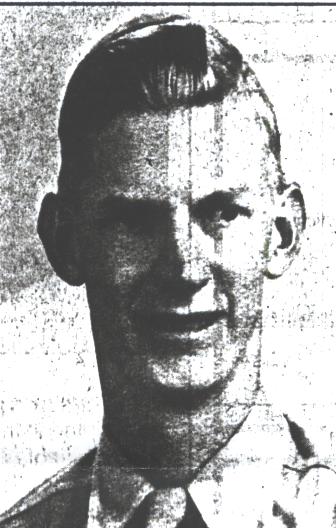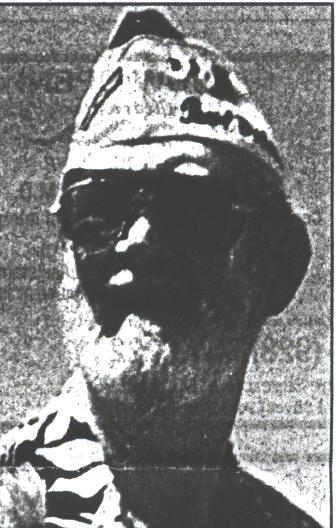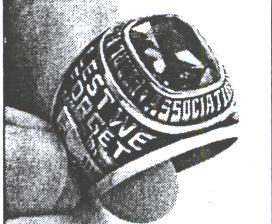Leo Stewart Wheeler Field |
As with any monumental event in one's life, 60 years after the Japanese attack on Pearl Harbor, survivors still find the tragic day a vivid memory. For Leo Stewart, the events began to unfold December 6th. "I think my biggest story would be what happened the day before. We had an inspection until noon on Saturday, and then we had to go to the firing range. Afterward we were all in the barracks cleaning our pistols. A fellow shot a round off, and hit this other fellow in the leg. Because of that, they took our ammunition away. I turned in my ammunition but kept my rifle and side arm," said Stewart. "I got hooked for guard duty on Saturday night and when I got off in the morning, I got something to eat and was going to get some rest. I heard what I thought was the Navy sending off planes from an aircraft carrier. Sometimes they'd buzz the Army on Wheeler Field and that's what I thought they were doing." "I went out to see what was gong on. There was a big explosion at the end of the field. I thought a plane had crashed, so I started hollering 'crash!' Just then, the second and third one came by and I saw meatballs (Japanese insignia) on the side and they dropped a bomb in the hanger across the street. Then I started hollering 'Japs!' I ran into the barracks and grabbed my pistol and the other guys who were on guard duty." "They (the Japanese planes) came back over Schofield Barracks, they came back strafing and there was about three or four of us in this one group. One guy hollered 'I'm shot,' and I didn't know it then, but he got shot through the earlobe. He was rubbing the side of his head with his hand and I guess because of the adrenaline, the blood was just running everywhere. "Another fellow, I remember his name was Marr, and I went across the street to the NCO living quarters. Of course the wives came running out of the housing, they were almost hysterical. We got them under a banyan tree, but then they shot through that, and we realized that was no place to be either, so we got them down into a ditch across the street." "By that time, there was so much smoke and fire we could hardly see. I went and got my rifle. The Japanese were flying so low; if they were smoking a cigarette you cold see it. I've shot ducks in Minnesota that were flying higher than those planes, but I still didn't have any ammo. That's when some of us broke into an ammo shop and we started shooting. But there was so much smoke we couldn't hit anything." "A major came down and grabbed three of us. He had us set up a 30-caliber machine gun. We were there for most of the day. I told him I gotta get back to guard duty and he said that wouldn't be a worry." "Eventually, the three of us were asked to guard a drainage pipe that came from a pineapple field". Stewart said they were issued a BAR (Browning Automatic Rifle). They were told not to wait for identification, told to shoot at anything that tried to come through the culvert. "But it wasn't a problem," said Stewart, "none of us knew how to use the BAR." "On Monday, I went into the office and the CO started chewing me out. He said they had had roll call and I was missing in action." "None of us had any sleep for three days. That night, Marr and I were on guard duty again, for the Wing Headquarters. Marr told me to get some sleep and he would wake me later. During the night, I woke up and an officer was tapping me on the helmet, asking if it was IK to go in. We were both sound asleep." "That was the extent of December sixth, seventh, eighth, and ninth for me," said Stewart. After the attack, the instrument repairman was sent by ship to Midway Island and eventually became a crew chief on Macon Island for a dive-bomber. Spending a lot of time on the runway, he said one day he saw a B-25 coming in and he knew something was wrong. Normally, he said, bombers didn't land on their field. His wheels were down, but as he touched down, the wheels collapsed. The plane slid 12 steps from where Stewart stood on his own plane. He climbed up on top of the fuselage, and looked in to the pilot's and co-pilot's compartment. He found the co-pilot with shrapnel in his leg; he had been hit in the head also, and was unconscious. Stewart reluctantly described the pilot's compartment as a terrible mess. He said the pilot looked up and simply said in a very weak voice, "Help me." Months later, back in Hawaii, Stewart finished some repairs, sent his plane off and went for some lunch. He said a pilot came into the PX, and asked for Sergeant Stewart. As Stewart introduced himself to Lieutenant Stranger, the pilot said, "I just want to thank you for saving my life on Macon Island." ____________________________________________________________________ Leo Stewart's 1939 class ring from Sebeka, Minnesota High School came through the Japanese attack on Pearl Harbor and four years of war. Not on his finger, though. "I was a mechanic and crew chief on airplanes and from pulling wrenches all the time, there was really nothing left to it," he said. "I bent it together and hung it on my dog tags." After the war, Stewart put his bent, gouged ring away with his dog tags. "Then last spring, I was going through some stuff and ran across the ring," he said. "I told my wife it would be interesting to Jostens to see what it had gone through." He sent the ring to the Bloomington company, which has supplied more than 50 million rings for high schools, colleges and athletic teams over the past century. Jostens decided to restore Stewart's 1939 ring and to create a 60th anniversary gold ring for him and all living Pearl Harbor survivors in Minnesota. |
Information provided by Leo Stewart |


